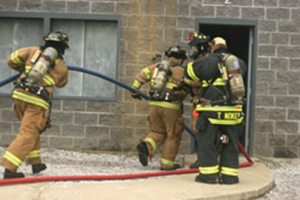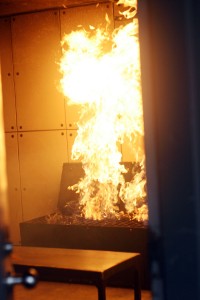By Allison Dooley/reporter

Photos by Corban La Fon/The Collegian
Men and women looking for firefighting careers are registering in increasing numbers for a class at the state-of-the-art firefighting facility on NW Campus.
The 14-week training class offered at the Fire Academy will help students earn a certificate and learn the skills they will need to join the profession.
Interest in the program is more popular than ever.
“[Firefighting] jobs are pretty recession-proof, and it’s a great opportunity for students,” said program senior secretary Debbie Moore. “The last couple of years there has been a steady increase in applications received at the academy.”

Students who pass a physical test and have an emergency medical technician certificate may be admitted into the class. Once the class starts, students will receive classroom training as well as emergency scenarios at the facility.
The Fire Academy has classrooms, a library/study hall, fire trucks, firefighting apparatus and a real fire station. They also have an area for rapid water rescue and a high-tech computer in the control room that can simulate fire and smoke in various locations at the facility such as a house, strip mall, hotel and a railroad yard with actual tank cars.
Each class has a limit of 24 students who attend five days a week. Getting into the class has become more competitive since the applications always exceed the 24 open spots.
“There have been so many applications lately,” said academy student Dustin Burnett. “Because of the bad economy, other jobs are going downhill, but there will always be a demand for firefighting and EMS.”
The academy offers the class three times a year and has started an additional online class.
When asked about a larger class size, Moore explained that more than 24 students could fit in the classroom setting.
However, training outside at the on-site location would be difficult because several additional instructors are needed to keep the ratio of instructors per student at a safe, manageable level.
“It makes you feel good that people are interested in this career,” said Fire Academy instructor and Mansfield firefighter Jason Hinton.
Hinton belonged to the academy’s fourth firefighting class taught in 1991. He has been a member of the firefighting staff for the past 15 years.
After students complete the course and take a test to become state-certified, they can apply at fire departments across the state.
TCC also tries to help students who graduate from the academy find jobs as firefighters.
“In as little time as one year, after taking a semester of paramedic school and one semester at the fire academy, students can find a great job and make good money doing something they love,” Moore said.
























